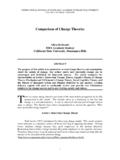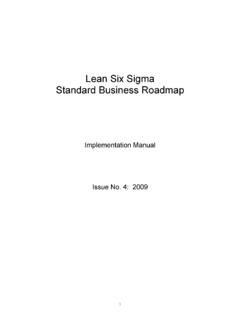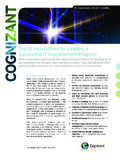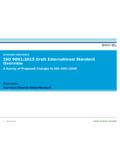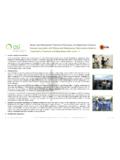Transcription of Roadmap to a Culture of Quality Improvement
1 Roadmap to a Culture of Quality ImprovementA guide to leadership and success in local health departments. FALL 2012 IntroductionTHE PUBLIC HEALTH FIELD IS A DYNAMIC ENVIRONMENT with new health issues emerging every day. In recent years, Quality Improvement (QI) has been introduced to, and embraced by, the eld of public health as a means to achieve ef ciencies and improve Quality of services during a time of tough economic and political pressures. Although QI has a notable presence in public health practice, isolated QI processes are not suf cient to balance budget cuts with competing public health priorities. Local health departments (LHDs) need a more comprehensive approach to transform organizational Culture , wherein the concepts of QI are ingrained in the shared attitudes, values, goals, and practices of all individuals in the LHD.
2 B eyond discrete process improvements, achieving and sustaining an integrated agency-wide Culture of QI is necessary to achieve ef ciencies, demonstrate return on investment, and ultimately impact health outcomes. About the Roadmap to a Culture of QIWhen initiating QI activity in LHDs, a natural evolution of change tends to occur, re ecting impact on both the people and processes within the organization. To gain a solid understanding of the barriers, drivers, and nuances along the journey to a QI Culture , the National Associa-tion of County and City Health Of cials (NACCHO) con-vened LHD staff responsible for leading QI efforts in their agencies across the country, as well as QI consultants who have worked with LHDs.
3 These experts discussed the vari-ous points along a spectrum regarding the uptake of QI in LHDs and strategies to move toward a Culture of QI. As a result of this meeting in April 2011, the foundation for this Roadmap to a Culture of QI (QI Roadmap ) was built, based on real experiences of practitioners in the eld. The QI Roadmap provides LHDs with guidance on pro-gressing through six phases or levels of QI integration until a Culture of QI has been reached and can be sustained. For each phase, the Roadmap presents common organization-al characteristics and incremental strategies for transition-ing to the next phase. The QI Roadmap also describes six foundational elements of a QI Culture that LHDs should cultivate over time.
4 Whether a novice or advanced in QI, any LHD can adapt the QI Roadmap as a guide to under-standing the current state and identifying next steps for advancing to the next stage of QI and QIThe Public Health Accreditation Board s (PHAB s) volun-tary, national accreditation program for state, local, and Tribal health departments, a cornerstone of which is QI, reinforces the increasing importance for system-wide QI in public health. The program s creators, whose development process included signi cant input from LHD practitioners, Quality Improvement (QI) in public health is defined as the use of a deliberate and defined Improvement process that is focused on activities that are responsive to community needs and improving population health.
5 QI is a continuous and ongoing effort to achieve measurable improvements in the efficiency, effectiveness, performance, accountability, outcomes, and other indicators of Quality in services or processes that achieve equity and improve the health of the to a Culture ofQuality Improvement2have carefully designed the accreditation process to en-sure evidence of continuous QI, whereby accredited health departments must not only apply for reaccreditation every ve years but must also submit annual reports demon-strating improvements in areas identi ed as weaknesses during the accreditation Further, Domain 9 of the PHAB Standards and Measures Version outlines speci c requirements related to performance management and PHAB is partly responsible for stimulating QI activity in the eld as several LHDs new to performance improve-ment have initiated QI as a result of preparing for accredi-tation.
6 Other LHDs that are generally more advanced in QI implement QI for the sole purpose of improving perfor-mance and use accreditation as a platform for continuous Whether accreditation is the impetus for QI, or vice versa, these two processes must be in Elements for Building a QI Culture The Culture of an organization is the embodiment of the core values, guiding principles, behaviors, and attitudes that collectively contribute to its daily O rgani-zational Culture is the very essence of how work is accom-plished; it matures over several years, during which norms are passed on from one generation of staff to the next.
7 Because Culture is ingrained in an organization, transform-ing Culture to embrace QI when minimal knowledge or experience with QI exists requires strong commitment and deliberate management of change over time. Each foundational element described below re ects a fundamental principle of Quality and is essential to achiev-ing transformational change. An organization s evolution from implementation of small, discrete QI efforts or an informal application of Quality concepts to complete infu-sion of QI into its Culture will occur through a process of cultivating these foundational elements over time. Vari-ous aspects of these elements are likely already present in many health departments, but each element must be fully developed to ensure sustainability of progress toward a strong QI Culture .
8 Leadership Commitment Senior leadership s com-mitment is vital for the success and sustainability of a QI Culture . The health director and senior manage-ment should initiate and lead the process for trans-formational change, dedicate nancial and human resources to QI, communicate progress, and exhibit lasting support for QI. Without leadership commit-ment, progress will diminish and likely result in re-lapse to the previous A primary role for senior leadership is change management. De ned as a structured approach to transitioning an organization from a current state to a future desired state, change management must be deliberately used to address challenges through-out the change When integrating QI into Culture , management can use change-management concepts and strategies to address both the process side of change ( , building the infrastructure, pro-cesses, and systems needed for effective QI) and the human side of change ( , alleviating staff resis-tance, maintaining transparency, meeting training needs, attaining staff support).
9 8 QI Infrastructure To a build Culture of QI, infra-structure must be in place to ensure that QI efforts are aligned with the organization s mission, vision, and strategic direction and that QI is linked to organi-zational performance. The following are components of a strong QI infrastructure: Performance Management System This cyclical process of measuring, monitoring, and reporting of progress toward strategic organization, division, and program goals and objectives provides a struc-tured, data-driven approach to identifying and pri-oritizing necessary QI The performance management system (PM system) should be guided by an agency s strategic plan.
10 PM/QI Council The performance management committee or QI Council (PM/QI Council) oversees the implementation of the PM system and QI ef-forts. This group of leaders and key staff is respon-sible for implementing, evaluating and revising the QI plan; supporting speci c QI projects; reviewing performance data and reporting progress; and rec-ommending next steps. All divisions/departments should be represented on the PM/QI (Members of a performance management commit-tee and QI council often overlap or are the same. For simplicity, the QI Roadmap de nes these terms as the same group). QI Plan Outlining the organization s QI goals and objectives, this living document provides di-rection and structure for QI efforts.
